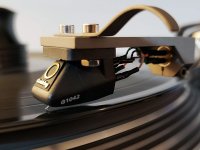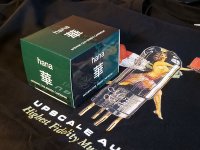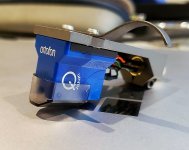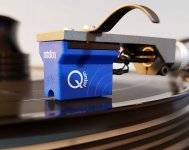Let's start the day on a positive note, shall we
 UPDATE: Goldring E3 MM Cartridge
UPDATE: Goldring E3 MM Cartridge
What’s better, going into something with high expectations and then not having those expectation quite met completely or going into something with no particular expectations and being hugely impressed? I would say the latter and it is definitely the case with the Goldring E3……. absolutely floored.
I hate the word “budget” in our hobby because it implies something of lesser quality, which the E3 is not, it’s best in its price range in my opinion and honestly outperformed some higher priced cartridges I’ve used. As usual, we gave the cart due time to get warmed up, we went 60ish hours on the E3, but honestly, from the first needle drop the sound got my attention, there was no mental note to not be too critical because it’s fresh out the box and needs some time, nope, it became “critical” listening from the get-go and only got better over time.
View attachment 93063
The E3 has a nice full, robust sound, full of energy and range. Beautiful separation and dynamics, clear clean highs and punchy lows, just a beautifully balanced cartridge. The E3 has an aluminum cantilever with a “superior bonded” super-elliptical stylus featuring a dual magnet design utilizing two low mass magnets interacting only with their paired pickup coil angled to match the cutting head arrangement enabling the cartridge to accurately trace the record groove resulting in better stereo separation and a more musical soundstage. Yes, a bit of technical jargon from the Goldring press release, but it delivers, it all comes through in the listening experience.
View attachment 93064
When listening to a range of genres from singer-songwriter fare with defined vocals to heavier classic rock and some punk, the E3 was solid across the board. Bringing vocals to a perfect pitch and tone while keeping any background vocals or harmonies smoothly delivered. Percussion and bass had impact, stood out really well against a black background giving a lot of the subtle details in a track a distinct place and position. Albums like St. Vincent’s stripped down MassEducation delivered smooth powerful vocals, from the near whispers to the high notes, the E3 did an amazing job of holding it together. Thomas Bartlett’s beautiful piano work shinned with every hammer hit and pluck being defined and resonating, each in their respective positions in the track. Going to a more classic rock album like Cheap Tricks Heaven Tonight, with hard guitar riffs and rapid-fire drum lines, the E3 again did an amazing job of bringing out the detail of each instruments, pluck, hit and range, Robin’s sometimes high, sometimes guttural voice had texture and presence, and nothing ever got muddied in the middle, with the same being said for The Clash’s Combat Rock, raw, present, everything in its place and sounding full of energy and life. The E3 does an exceptional job at grabbing and placing highs, mids and lows in their place and showcasing each one’s tone and position, truly a pleasing balancing act. The E3 leans ever so slightly to the warm side, showing remarkable clarity and character in its sound signature, and has become one of my favorite cartridges, its musical, accurate, fun and plows its way through most pressings with its chest out and chin up.
Fitting the cart is quite simple, the threaded body is always a plus and its angled design helped with alignment and stylus placement greatly. The E3 has a user replaceable stylus in a “plug and play” set up, pop the used cart off and pop on the new. Going back to my opening statement, even with all that I’ve mentioned about the E3, I still feel I’m not expressing how impressed I am with this “budget” cartridge, it is an amazing value for its price point and easily one of the best among other cartridges not only in its price pool, but even some higher ones.
Highly, highly recommended bang for your buck. Big sound with a small price.
I want to thank Goldring for lending out the E3 for me to play with, the Goldring line is distributed in the US by American Audio & Video, the Goldring line and E3 are available at LP Gear and other retailers for $170, with replacement styli running $125. For more information on Goldring visit their Official site at www.goldring.co.uk.



